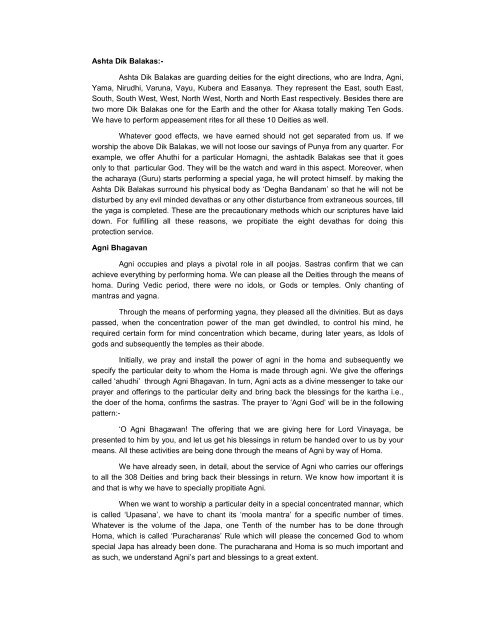SREE AMRITHA CHIRANJEEVINI TEMPLES - Amirdham
SREE AMRITHA CHIRANJEEVINI TEMPLES - Amirdham
SREE AMRITHA CHIRANJEEVINI TEMPLES - Amirdham
Create successful ePaper yourself
Turn your PDF publications into a flip-book with our unique Google optimized e-Paper software.
Ashta Dik Balakas:-<br />
Ashta Dik Balakas are guarding deities for the eight directions, who are Indra, Agni,<br />
Yama, Nirudhi, Varuna, Vayu, Kubera and Easanya. They represent the East, south East,<br />
South, South West, West, North West, North and North East respectively. Besides there are<br />
two more Dik Balakas one for the Earth and the other for Akasa totally making Ten Gods.<br />
We have to perform appeasement rites for all these 10 Deities as well.<br />
Whatever good effects, we have earned should not get separated from us. If we<br />
worship the above Dik Balakas, we will not loose our savings of Punya from any quarter. For<br />
example, we offer Ahuthi for a particular Homagni, the ashtadik Balakas see that it goes<br />
only to that particular God. They will be the watch and ward in this aspect. Moreover, when<br />
the acharaya (Guru) starts performing a special yaga, he will protect himself. by making the<br />
Ashta Dik Balakas surround his physical body as ‘Degha Bandanam’ so that he will not be<br />
disturbed by any evil minded devathas or any other disturbance from extraneous sources, till<br />
the yaga is completed. These are the precautionary methods which our scriptures have laid<br />
down. For fulfilling all these reasons, we propitiate the eight devathas for doing this<br />
protection service.<br />
Agni Bhagavan<br />
Agni occupies and plays a pivotal role in all poojas. Sastras confirm that we can<br />
achieve everything by performing homa. We can please all the Deities through the means of<br />
homa. During Vedic period, there were no idols, or Gods or temples. Only chanting of<br />
mantras and yagna.<br />
Through the means of performing yagna, they pleased all the divinities. But as days<br />
passed, when the concentration power of the man get dwindled, to control his mind, he<br />
required certain form for mind concentration which became, during later years, as Idols of<br />
gods and subsequently the temples as their abode.<br />
Initially, we pray and install the power of agni in the homa and subsequently we<br />
specify the particular deity to whom the Homa is made through agni. We give the offerings<br />
called ‘ahudhi’ through Agni Bhagavan. In turn, Agni acts as a divine messenger to take our<br />
prayer and offerings to the particular deity and bring back the blessings for the kartha i.e.,<br />
the doer of the homa, confirms the sastras. The prayer to ‘Agni God’ will be in the following<br />
pattern:-<br />
‘O Agni Bhagawan! The offering that we are giving here for Lord Vinayaga, be<br />
presented to him by you, and let us get his blessings in return be handed over to us by your<br />
means. All these activities are being done through the means of Agni by way of Homa.<br />
We have already seen, in detail, about the service of Agni who carries our offerings<br />
to all the 308 Deities and bring back their blessings in return. We know how important it is<br />
and that is why we have to specially propitiate Agni.<br />
When we want to worship a particular deity in a special concentrated mannar, which<br />
is called ‘Upasana’, we have to chant its ‘moola mantra’ for a specific number of times.<br />
Whatever is the volume of the Japa, one Tenth of the number has to be done through<br />
Homa, which is called ‘Puracharanas’ Rule which will please the concerned God to whom<br />
special Japa has already been done. The puracharana and Homa is so much important and<br />
as such, we understand Agni’s part and blessings to a great extent.


